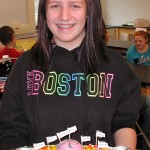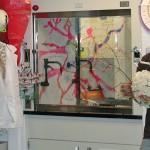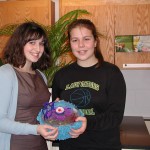HUNTINGTON – It was an interesting – and flavorful – science project.
Jr. High School students Alyssa Donaruma and Justine Braman showed their masterpiece, made from graham crackers, fruit roll ups, twizzlers, and jelly beans.
The assignment? Create a representation of a plant or animal cell using food, for 7th grade science teacher Sara McNamara.
Students had to denote the nucleus, cell membrane, lysosomes, endoplasmic reticulum, cytoplasm, ribosomes, golgi bodies, chromatin, mitochondrion, and vacuoles in their representation. Many students opted to use colors for each sub-part from a previous class assignment—that had them use light blue for the cell membrane, purple for the nucleus, black for the ribosomes, and red for the golgi bodies.
On December 14, each 7th grade science class presented their “cells”, which featured anything from a food-dyed “snowball” snack cake for a nucleus, to crushed Oreos for the cell wall.
Meanwhile, on the other side of the Gateway complex, students in Cyndi Jensen’s Introduction to Cell Functions Advanced Biology class also presented reports on cell models that they had created—using everything from boxes, pvc pipe, candle gel, pipe cleaners, fast-acting foam insulation and other unusual materials. Each group had chosen a different cell, and had to not only present their model but explain what each cell meant to us, as humans.
Cory Bisbee, Brian Lak and Casey Pease—the E.coli presenters—noted that the pili on the outside of the cell helps it sense its environment, move, and attach to other cells. “When the E.coli cell is under stress—such as when it is attacked by antibiotic medications—it passes some of its DNA to another cell, which begins the process of creating antibiotic resistant cells,” Jensen reminded the class.




